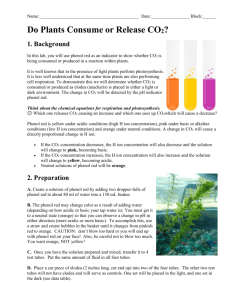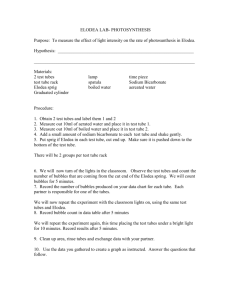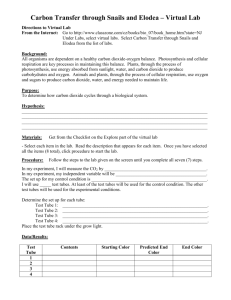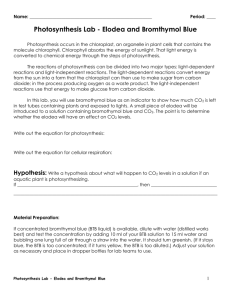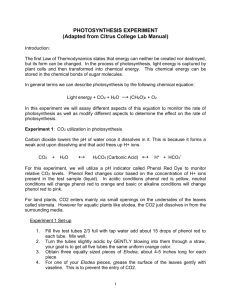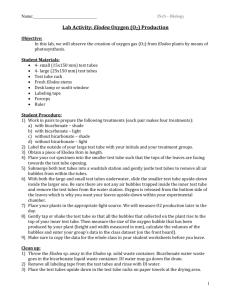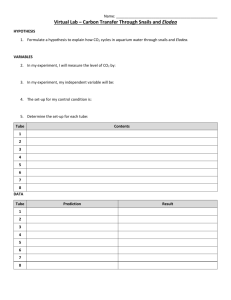The Red and the Yellow: Carbon Fixation
advertisement
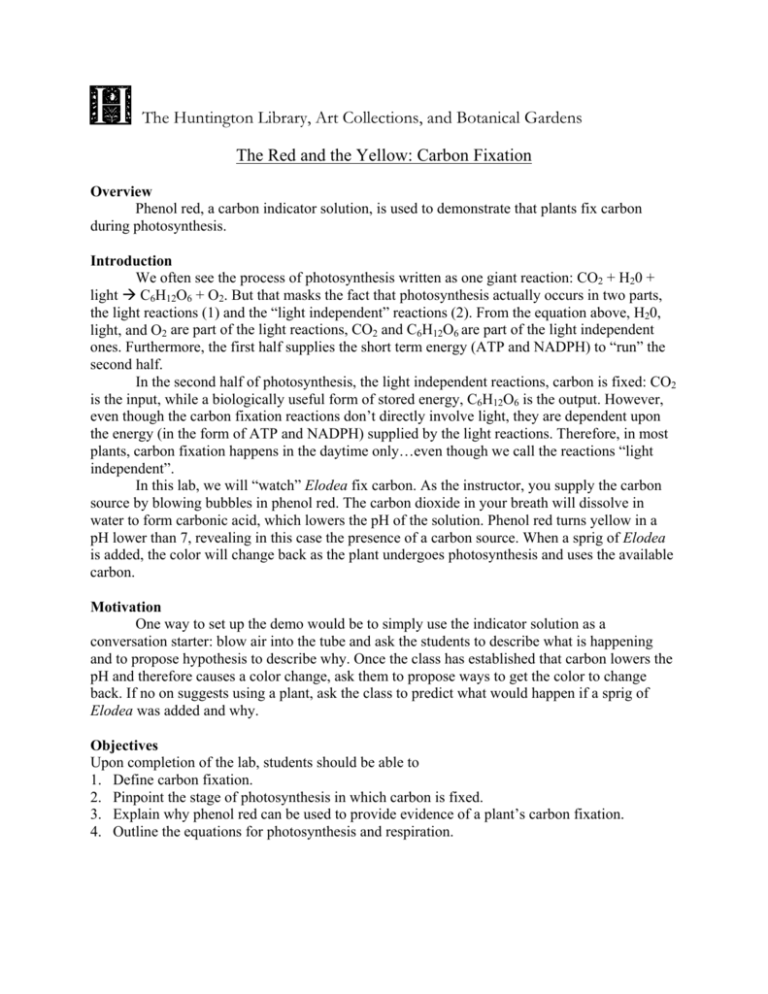
The Huntington Library, Art Collections, and Botanical Gardens The Red and the Yellow: Carbon Fixation Overview Phenol red, a carbon indicator solution, is used to demonstrate that plants fix carbon during photosynthesis. Introduction We often see the process of photosynthesis written as one giant reaction: CO2 + H20 + light Æ C6H12O6 + O2. But that masks the fact that photosynthesis actually occurs in two parts, the light reactions (1) and the “light independent” reactions (2). From the equation above, H20, light, and O2 are part of the light reactions, CO2 and C6H12O6 are part of the light independent ones. Furthermore, the first half supplies the short term energy (ATP and NADPH) to “run” the second half. In the second half of photosynthesis, the light independent reactions, carbon is fixed: CO2 is the input, while a biologically useful form of stored energy, C6H12O6 is the output. However, even though the carbon fixation reactions don’t directly involve light, they are dependent upon the energy (in the form of ATP and NADPH) supplied by the light reactions. Therefore, in most plants, carbon fixation happens in the daytime only…even though we call the reactions “light independent”. In this lab, we will “watch” Elodea fix carbon. As the instructor, you supply the carbon source by blowing bubbles in phenol red. The carbon dioxide in your breath will dissolve in water to form carbonic acid, which lowers the pH of the solution. Phenol red turns yellow in a pH lower than 7, revealing in this case the presence of a carbon source. When a sprig of Elodea is added, the color will change back as the plant undergoes photosynthesis and uses the available carbon. Motivation One way to set up the demo would be to simply use the indicator solution as a conversation starter: blow air into the tube and ask the students to describe what is happening and to propose hypothesis to describe why. Once the class has established that carbon lowers the pH and therefore causes a color change, ask them to propose ways to get the color to change back. If no on suggests using a plant, ask the class to predict what would happen if a sprig of Elodea was added and why. Objectives Upon completion of the lab, students should be able to 1. Define carbon fixation. 2. Pinpoint the stage of photosynthesis in which carbon is fixed. 3. Explain why phenol red can be used to provide evidence of a plant’s carbon fixation. 4. Outline the equations for photosynthesis and respiration. Materials • Phenol red 0.02% aqueous solution • Sprig of Elodea • Test tubes • Straw Associated California State Biology Standards 1f. Students know usable energy is captured from sunlight by chloroplasts and is stored through the synthesis of sugar from carbon dioxide. Procedure 1. Fill a large test tube with enough of the phenol red so that equal amounts can later be divided amongst two of the tubes. 2. With a straw, gently and carefully blow into the solution until it turns yellow. The more carbonic acid in the solution, the longer the demonstration will take, so stop as soon as the color is clearly yellow. Divide the solution equally among two tubes. 3. Add a sprig of Elodea to one of the tubes, so that it is just covered by the solution. 4. Place both tubes under your Fast Plant grow lights and monitor any changes in color over the next 30 minutes to 2 hours. Evaluation The following questions are listed under the Analysis section of the student handout and maybe used as part of a report, class discussion or assessment. 1. Why does the phenol red change color when we blow bubbles into the tube? Phenol red is an indicator in this experiment. What did it indicate? 2. How long did it take to observe a color change in the phenol red? What does the color change indicate in terms of the Elodea plant? 3. If carbon fixation occurs during the light independent stage of photosynthesis, why did the procedure call for placement of the test tubes under the light banks? 4. Did you see a change in color of the phenol red test tube with no elodea added? Why or why not? 5. Does carbon fixation occur in humans? Can you think of any other organisms that fix carbon? 6. How is does a plant use carbon? What is meant by the term “carbon fixation”? 7. Identify and explain the control in this experiment. Extension Activities 1. Can the phenol red solutions and Elodea be used to illustrate the process of cellular respiration? Why or why not? 2. You are the project manager of a new eco-friendly development company in Ecuador. In order to build, you need lots of timber. The rainforest has plenty of timber, but you know that slashing and burning rainforests contributes to global warming. Why does cutting down large forests contribute to global warming? What might trees give or take from their environment that balances the output of human consumption? Create an argument for your bosses to use more environmentally friendly methods of timber collection. Test Preparation 1. During the second phase the “light independent” reactions, what is molecule is fixed to create C6H12O6? (A) Carbon dioxide (B) oxygen (C) light (D) water Student Sheet--The Red and the Yellow: Carbon Fixation Procedure 1. Your teacher will fill a large test tube with enough of the phenol red so that equal amounts can later be divided amongst two of the tubes. 2. The teacher will gently and carefully blow with a straw into the solution until it turns yellow. This will inject carbonic acid into the solution. Divide the solution equally among two tubes. 3. A sprig of Elodea will be added to one of the tubes, so that it is just covered by the solution. 4. Place both tubes under the grow lights and monitor any changes in color over the next 30 minutes to 2 hours. Table 1: Phenol Red Experiment Color Change? Interpretation Test Tube 1 – no Elodea Test Tube 2- Elodea Added Analysis On a separate sheet of paper please complete the following: 1. Why does the phenol red change color when we blow bubbles into the tube? Phenol red is an indicator in this experiment. What did it indicate? 2. How long did it take to observe a color change in the phenol red? What does the color change indicate in terms of the Elodea plant? 3. If carbon fixation occurs during the light independent stage of photosynthesis, why did the procedure call for placement of the test tubes under the light banks? 4. Did you see a change in color of the phenol red test tube with no elodea added? Why or why not? 5. Does carbon fixation occur in humans? Can you think of any other organisms that fix carbon? 6. How is does a plant use carbon? What is meant by the term “carbon fixation”? 7. Identify and explain the control in this experiment.
